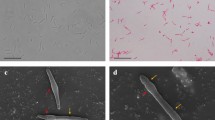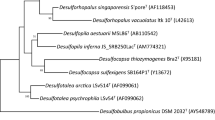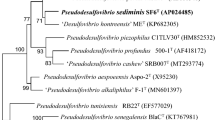Abstract
A novel sulfate-reducing bacterium designated OPF15T was isolated from Obsidian Pool, Yellowstone National Park, Wyoming. The phylogeny of 16S rRNA and functional genes (dsrAB) placed the organism within the family Thermodesulfobacteriaceae. The organism displayed hyperthermophilic temperature requirements for growth with a range of 70–90 °C and an optimum of 83 °C. Optimal pH was around 6.5–7.0 and the organism required the presence of H2 or formate as an electron donor and CO2 as a carbon source. Electron acceptors supporting growth included sulfate, thiosulfate, and elemental sulfur. Lactate, acetate, pyruvate, benzoate, oleic acid, and ethanol did not serve as electron donors. Membrane lipid analysis revealed diacyl glycerols and acyl/ether glycerols which ranged from C14:0 to C20:0. Alkyl chains present in acyl/ether and diether glycerol lipids ranged from C16:0 to C18:0. Straight, iso- and anteiso-configurations were found for all lipid types. The presence of OPF15T was also shown to increase cellulose consumption during co-cultivation with Caldicellulosiruptor obsidiansis, a fermentative, cellulolytic extreme thermophile isolated from the same environment. On the basis of phylogenetic, phenotypic, and structural analyses, Thermodesulfobacterium geofontis sp. nov. is proposed as a new species with OPF15T representing the type strain.




Similar content being viewed by others
Abbreviations
- DSR:
-
Dissimilatory sulfite reductase
- SRM:
-
Sulfate-reducing microorganisms
- YNP:
-
Yellowstone National Park
- OP:
-
Obsidian Pool
- IPLs:
-
Intact polar lipids
- PE:
-
Phosphoethanolamine
- APT:
-
Phosphoaminopentanetetrol
- Phex:
-
Phosphohexose
- DAG:
-
Diacyl glycerol
- AEG:
-
Acyl/ether glycerol
- DEG:
-
Diether glycerol
References
Achenbach-Richter L, Stetter KO, Woese CR (1987) A possible biochemical missing link among archaebacteria. Nature 327:348–349
Barns SM, Fundyga RE, Jeffries MW, Pace NR (1994) Remarkable archaeal diversity detected in a Yellowstone National Park hot-spring environment. Proc Natl Acad Sci USA 91:1609–1613
Bligh EG, Dyer WJ (1959) A rapid method of total lipid extraction and purification. Can J Biochem Physiol 37:911–917
Blöchl E, Rachel R, Burggraf S, Hafenbradl D, Jannasch HW, Stetter KO (1997) Pyrolobus fumarii, gen. and sp. nov., represents a novel group of archaea, extending the upper temperature limit for life to 113 °C. Extremophiles 1:14–21
Bradley AS, Fredericks H, Hinrichs K-U, Summons RE (2009) Structural diversity of diether lipids in carbonate chimneys at the Lost City Hydrothermal Field. Org Geochem 40:1169–1178
Burggraf S, Jannasch HW, Nicolaus B, Stetter KO (1990) Archaeoglobus profundus sp. nov., represents a new species within the sulfate-reducing archaebacteria. Syst Appl Microbiol 13:24–28
Cameron EM (1982) Sulfate and sulfate reduction in early precambrian oceans. Nature 296:145–148
Cline JD (1969) Spectrophotometric determination of hydrogen sulfide in natural waters. Limnol Oceanogr 14:454–458
DeSantis TZ, Hugenholtz P, Larsen N, Rojas M, Brodie EL, Keller K, Huber T, Dalevi D, Hu P, Andersen GL (2006) Greengenes, a chimera-checked 16S rRNA gene database and workbench compatible with ARB. Appl Environ Microb 72:5069–5072
Elkins JG, Podar M, Graham DE, Makarova KS, Wolf Y, Randau L, Hedlund BP, Brochier C, Kunin V, Anderson I, Lapidus A, Goltsman E, Berry K, Koonin EV, Hugenholtz P, Kyrpides N, Wanner G, Richardson P, Keller M, Stetter KO (2008) A korarchaeal genome reveals insights into the evolution of the Archaea. P Natl Acad Sci USA 105:8102–8107
Fishbain S, Dillon JG, Gough HL, Stahl DA (2003) Linkage of high rates of sulfate reduction in Yellowstone hot springs to unique sequence types in the dissimilatory sulfate respiration pathway. Appl Environ Microb 69:3663–3667
Hamilton-Brehm SD, Mosher JJ, Vishnivetskaya T, Podar M, Carroll S, Allman S, Phelps TJ, Keller M, Elkins JG (2010) Caldicellulosiruptor obsidiansis sp. nov., an anaerobic, extremely thermophilic, cellulolytic bacterium isolated from Obsidian Pool, Yellowstone National Park. Appl Environ Microb 76:1014–1020
Hatchikian EC, Zeikus JG (1983) Characterization of a new type of dissimilatory sulfite reductase present in Thermodesulfobacterium commune. J Bacteriol 153:1211–1220
Henry EA, Devereux R, Maki JS, Gilmour CC, Woese CR, Mandelco L, Schauder R, Remsen CC, Mitchell R (1994) Characterization of a new thermophilic sulfate-reducing bacterium Thermodesulfovibrio yellowstonii, gen. nov. and sp. nov.: its phylogenetic relationship to Thermodesulfobacterium commune and their origins deep within the bacterial domain. Arch Microbiol 161:62–69
Huber R, Wilharm T, Huber D, Trincone A, Burggraf S, König H, Reinhard R, Rockinger I, Fricke H, Stetter KO (1992) Aquifex pyrophilus gen. nov. sp. nov., represents a novel group of marine hyperthermophilic hydrogen-oxidizing bacteria. Syst Appl Microbiol 15:340–351
Huber R, Huber H, Stetter KO (2000) Towards the ecology of hyperthermophiles: biotopes, new isolation strategies and novel metabolic properties. FEMS Microbiol Rev 24:615–623
Hugenholtz P, Pitulle C, Hershberger KL, Pace NR (1998) Novel division level bacterial diversity in a Yellowstone hot spring. J Bacteriol 180:366–376
Itoh T, Suzuki K, Nakase T (1998) Thermocladium modestius gen. nov., sp. nov., a new genus of rod-shaped, extremely thermophilic crenarchaeote. Int J Syst Bacteriol 48:879–887
Itoh T, Suzuki K, Sanchez PC, Nakase T (1999) Caldivirga maquilingensis gen. nov., sp nov., a new genus of rod-shaped crenarchaeote isolated from a hot spring in the Philippines. Int J Syst Bacteriol 49:1157–1163
Jeanthon C, L’Haridon S, Cueff V, Banta A, Reysenbach A-L, Prieur D (2002) Thermodesulfobacterium hydrogeniphilum sp. nov., a thermophilic, chemolithoautotrophic, sulfate-reducing bacterium isolated from a deep-sea hydrothermal vent at Guaymas Basin, and emendation of the genus Thermodesulfobacterium. Int J Syst Evol Microbiol 52:765–772
Jørgensen BB, Isaksen MF, Jannasch HW (1992) Bacterial sulfate reduction above 100 °C in deep-sea hydrothermal vent sediments. Science 258:1756–1757
Kashefi K, Lovley DR (2003) Extending the upper temperature limit for life. Science 301:934
Kashefi K, Holmes DE, Reysenbach A-L, Lovley DR (2002) Use of Fe(III) as an electron acceptor to recover previously uncultured hyperthermophiles: isolation and characterization of Geothermobacterium ferrireducens gen. nov., sp nov. Appl Environ Microb 68:1735–1742
Klein M, Friedrich M, Roger AJ, Hugenholtz P, Fishbain S, Abicht H, Blackall LL, Stahl DA, Wagner M (2001) Multiple lateral transfers of dissimilatory sulfite reductase genes between major lineages of sulfate-reducing prokaryotes. J Bacteriol 183:6028–6035
Langworthy TA, Holzer G, Zeikus JG, Tornabene TG (1983) Iso-branched and anteiso-branched glycerol diethers of the thermophilic anaerobe Thermodesulfotobacterium commune. Syst Appl Microbiol 4:1–17
Ludwig W, Strunk O, Westram R, Richter L, Meier H, Yadhukumar, Buchner A, Lai T, Steppi S, Jobb G, Förster W, Brettske I, Gerber S, Ginhart AW, Gross O, Grumann S, Hermann S, Jost R, König A, Liss T, Lüßmann R, May M, Björn N, Reichel B, Strehlow R, Stamatakis A, Stuckmann N, Vilbig A, Lenke M, Ludwig T, Bode A, Schleifer K-H (2004) ARB: a software environment for sequence data. Nucleic Acids Res 32:1363–1371
Miller TL, Wolin MJ (1974) Serum bottle modification of Hungate technique for cultivating obligate anaerobes. Appl Microbiol 27:985–987
Miller LD, Mosher JJ, Venkateswaran A, Yang ZK, Palumbo AV, Phelps TJ, Podar M, Schadt CW, Keller M (2010) Establishment and metabolic analysis of a model microbial community for understanding trophic and electron accepting interactions of subsurface anaerobic environments. BMC Microbiol 10:149
Miroshnichenko ML, Lebedinsky AV, Chernyh NA, Tourova TP, Kolganova TV, Spring S, Bonch-Osmolovskaya EA (2009) Caldimicrobium rimae gen. nov., sp nov., an extremely thermophilic, facultatively lithoautotrophic, anaerobic bacterium from the Uzon Caldera, Kamchatka. Int J Syst Evol Micr 59:1040–1044
Mori K, Hanada S (2009) Family II. Thermodesulfobiaceae In: De Vos P, Garrity GM, Jones D, Krieg NR, Ludwig W, Rainey FA, Schleifer KH, Whitman B (eds) Bergey’s manual of systematic bacteriology, 2nd edn., vol 3. The Firmicutes. Springer, Dordrecht, pp 1268–1271
Muyzer G, Stams AJM (2008) The ecology and biotechnology of sulphate-reducing bacteria. Nat Rev Microbiol 6:441–454
Pancost RD, Bouloubassi I, Aloisi G, Sinninghe Damsté JS, Party The Medinaut Shipboard Scientific (2001) Three series of non-isoprenoidal dialkyl glycerol diethers in cold-seep carbonate crusts. Org Geochem 32:695–707
Postgate J (1959) A diagnostic reaction of Desulphovibrio desulphuricans. Nature 14:481–482
Reysenbach A-L, Wickham GS, Pace NR (1994) Phylogenetic analysis of the hyperthermophilic pink filament community in Octopus Spring, Yellowstone National Park. Appl Environ Microb 60:2113–2119
Reysenbach A-L, Ehringer H, Hershberger K (2000) Microbial diversity at 83 °C in Calcite Springs, Yellowstone National Park: another environment where the Aquificales and “Korarchaeota” coexist. Extremophiles 4:61–67
Ronquist F, Huelsenbeck JP (2003) MrBayes 3: Bayesian phylogenetic inference under mixed models. Bioinformatics 19:1572–1574
Sasaki D, Morita M, Sasaki K, Watanabe A, Ohmura N (2012) Acceleration of cellulose degradation and shift of product via methanogenic co-culture of a cellulolytic bacterium with a hydrogenotrophic methanogen. J Biosci Bioeng 114:435–439
Schink B (2002) Synergistic interactions in the microbial world. Antonie van Leeuwenhoek 81:257–261
Shen YA, Buick R, Canfield DE (2001) Isotopic evidence for microbial sulphate reduction in the early Archaean era. Nature 410:77–81
Sinninghe Damsté JS, Rijpstra WIC, Hopmans EC, Weijers JWH, Foesel BU, Overmann J, Dedysh SN (2011) 13, 16-Dimethyl octacosanedioic acid (iso-diabolic acid), a common membrane-spanning lipid of acidobacteria subdivisions 1 and 3. Appl Environ Microb 77:4147–4154
Sonne-Hansen J, Ahring BK (1999) Thermodesulfobacterium hveragerdense sp. nov., and Thermodesulfovibrio islandicus sp. nov., two thermophilic sulfate reducing bacteria isolated from a Icelandic hot spring. Syst Appl Microbiol 22:559–564
Spear JR, Walker JJ, McCollom TM, Pace NR (2005) Hydrogen and bioenergetics in the Yellowstone geothermal ecosystem. Proc Natl Acad Sci USA 102:2555–2560
Steinsbu BO, Thorseth IH, Nakagawa S, Inagaki F, Lever MA, Engelen B, Øvreås L, Pedersen RB (2010) Archaeoglobus sulfaticallidus sp. nov., a thermophilic and facultatively lithoautotrophic sulfate-reducer isolated from black rust exposed to hot ridge flank crustal fluids. Int J Syst Evol Micr 60:2745–2752
Stetter KO (1988) Archaeoglobus fulgidus gen. nov., sp. nov.: a new taxon of extremely thermophilic archaebacteria. Syst Appl Microbiol 10:172–173
Stetter KO (1999) Extremophiles and their adaptation to hot environments. FEBS Lett 452:22–25
Stetter KO, Lauerer G, Thomm M, Neuner A (1987) Isolation of extremely thermophilic sulfate reducers: evidence for a novel branch of archaebacteria. Science 236:822–824
Stetter KO, Huber R, Blöchl E, Kurr M, Eden RD, Fielder M, Cash H, Vance I (1993) Hyperthermophilic archaea are thriving in deep North Sea and Alaskan oil reservoirs. Nature 365:743–745
Sturt HF, Summons RE, Smith K, Elvert M, Hinrichs KU (2004) Intact polar membrane lipids in prokaryotes and sediments deciphered by high-performance liquid chromatography/electrospray ionization multistage mass spectrometry—new biomarkers for biogeochemistry and microbial ecology. Rapid Commun Mass Sp 18:617–628
Tamura K, Dudley J, Nei M, Kumar S (2007) MEGA4: molecular evolutionary genetics analysis (MEGA) software version 4.0. Mol Biol Evol 24:1596–1599
van Niel EWJ, Claassen PAM, Stams AJM (2003) Substrate and product inhibition of hydrogen production by the extreme thermophile, Caldicellulosiruptor saccharolyticus. Biotechnol Bioeng 81:255–262
Verhaart MRA, Bielen AAM, van der Oost J, Stams AJM, Kengen SWM (2010) Hydrogen production by hyperthermophilic and extremely thermophilic bacteria and archaea: mechanisms for reductant disposal. Environ Technol 31:993–1003
Wagner M, Roger AJ, Flax JL, Brusseau GA, Stahl DA (1998) Phylogeny of dissimilatory sulfite reductases supports an early origin of sulfate respiration. J Bacteriol 180:2975–2982
Widdel F, Pfennig N (1981) Studies on dissimilatory sulfate-reducing bacteria that decompose fatty acids. I. Isolation of new sulfate-reducing bacteria enriched with acetate from saline environments. Description of Desulfobacter postgatei gen. nov., sp. nov. Arch Microbiol 129:395–400
Wolin EA, Wolin MJ, Wolfe RS (1963) Formation of methane by bacterial extracts. J Biol Chem 238:2882–2886
Zeikus JG, Dawson MA, Thompson TE, Ingvorsen K, Hatchikian EC (1983) Microbial ecology of volcanic sulfidogenesis—isolation and characterization of Thermodesulfobacterium commune gen. nov. and sp. nov. J Gen Microbiol 129:1159–1169
Zellner G, Stackebrandt E, Kneifel H, Messner P, Sleytr UB, Conway de Macario E, Zabel H-P, Stetter KO, Winter J (1989) Isolation and characterization of a thermophilic, sulfate reducing archaebacterium, Archaeoglobus fulgidus strain Z. Syst Appl Microbiol 11:151–160
Zverlov V, Klein M, Lücker S, Friedrich MW, Kellermann J, Stahl DA, Loy A, Wagner M (2005) Lateral gene transfer of dissimilatory (bi)sulfite reductase revisited. J Bacteriol 187:2203–2208
Acknowledgments
We thank Sarah J. Kauffman for her invaluable technical assistance. We also thank Brian P. Hedlund, Christie Hendrix, and the National Park Service for sample collection under permit #YELL-SCI-0115 (PI: Karl O. Stetter). Christopher W. Schadt and Dwayne A. Elias provided helpful comments during preparation of the manuscript. Support for S. D. H.-B. and J. G. E. was provided by the BioEnergy Science Center (BESC), which is a U.S. Department of Energy Bioenergy Research Center supported by the Office of Biological and Environmental Research in the DOE Office of Science, Oak Ridge National Laboratory. Oak Ridge National Laboratory is managed by UT-Battelle, LLC, for the U.S. Department of Energy under contract DE-AC05-00OR22725. The research was partially funded by the Netherlands Darwin Centre for Biogeosciences by a grant for a post-doctoral fellowship (R.A.G.) to J.S.S.D.
Author information
Authors and Affiliations
Corresponding author
Additional information
Communicated by A. Oren.
Electronic supplementary material
Below is the link to the electronic supplementary material.
Rights and permissions
About this article
Cite this article
Hamilton-Brehm, S.D., Gibson, R.A., Green, S.J. et al. Thermodesulfobacterium geofontis sp. nov., a hyperthermophilic, sulfate-reducing bacterium isolated from Obsidian Pool, Yellowstone National Park. Extremophiles 17, 251–263 (2013). https://doi.org/10.1007/s00792-013-0512-1
Received:
Accepted:
Published:
Issue Date:
DOI: https://doi.org/10.1007/s00792-013-0512-1




